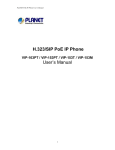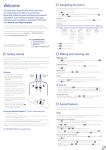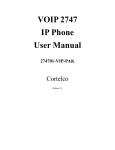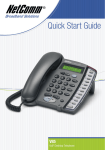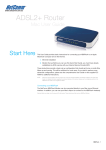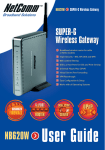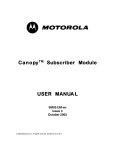Download NetComm V85 User's Manual
Transcript
Contents Chaper 1: Introduction ......................................................................................... 4 About VoIP ................................................................................................... 4 Chapter 2: Getting to know your V85 ..................................................................... 6 Before you begin... ......................................................................................... 6 Package Contents ........................................................................................... 7 Rear of the V85 .............................................................................................. 8 Chapter 3: Getting your V85 Up and Running .......................................................... 9 Installation Environment .................................................................................. 9 Step 1: Connecting your V85......................................................................... 10 Step 2: Getting the V85 up and running ......................................................... 10 Step 3: Configuring your VoIP Account Details ................................................. 12 Step 4: Reboot the V85 ................................................................................ 14 Step 5: Checking Your V85 Status .................................................................. 15 Chapter 4: Configuring your V85 via the Keypad.................................................... 16 Keypad Function Definition............................................................................. 16 Summary of Key Functions and Displays .......................................................... 17 Further Network Configuration Options ............................................................ 20 Dynamic IP Method (DHCP)............................................................................ 20 Static IP Method ........................................................................................... 20 PPPoE Method .............................................................................................. 20 Network Settings Verification ......................................................................... 21 VoIP (SIP) Configuration................................................................................ 21 Keypad “View” Operation ............................................................................... 23 Network settings .......................................................................................... 23 Ping utility ................................................................................................... 23 Restart ........................................................................................................ 23 Firmware Version ......................................................................................... 23 Packet Trace ................................................................................................ 23 Call Forward Configuration ............................................................................. 24 Chapter 5: V85 Web-based Configuration ............................................................. 25 Web Login ................................................................................................... 25 V85 Network Menu ....................................................................................... 26 SIP Configuration ......................................................................................... 27 Phone Configuration...................................................................................... 30 System Configuration .................................................................................... 31 Chapter 6: Call Handling .................................................................................... 32 Making Calls ................................................................................................ 32 Receiving Calls ............................................................................................. 32 Check call history (incoming / outgoing / missed calls) ...................................... 32 Auto Redial .................................................................................................. 32 Call Forward ................................................................................................ 32 Call Hold ..................................................................................................... 35 Phone Book and Speed Dial............................................................................ 35 2 V85 Desktop VoIP Phone User Guide YML772 Rev1 Appendix A: V85 Keypad Configuration Menu Structure ......................................... 36 Appendix B: V85 Status and Error Messages ........................................................ 40 Appendix C: Setting your Computer’s IP Address .................................................. 41 Appendix D: Alternative V85 Connection Types ..................................................... 44 Examples of V85 Port-Forwarding Configuration ................................................ 45 Appendix E: Summary of Key Features and Hardware ............................................ 47 Hardware Specifications ................................................................................ 48 Appendix F: Glossary of Network and VoIP Terms................................................... 49 Appendix G: Cable Information ........................................................................... 57 Appendix H: Registration and Warranty Information .............................................. 59 V85 Desktop VoIP Phone User Guide YML772 Rev1 3 Chaper 1: Introduction NetComm’s V85 VoIP Desktop Phone is a next-generation IP Phone that provides a costeffective solution for home and SOHO users who want to use their broadband Internet connections to make telephone calls. The V85 supports the popular SIP protocol allowing for ease of installation with VoIP service providers. By using state-of-the-art DSP (Digital Signal Processing) technology, the V85 delivers outstanding voice quality that is comparable to the PSTN (normal phone) voice quality. With the built-in LCD display, the user can easily configure and view phone settings and phone book entries. Besides providing advanced VoIP functions, the V85 also provides rich telephone features such as last number redial, call forward/transfer, call history, and volume adjustment for loudspeaker and handset. NetComm’s V85 is an ideal VoIP solution for nextgeneration telephone communication. About VoIP Voice Over Internet Protocol uses Broadband technology to establish a communications link between two (or more) communications devices. In so doing, VoIP bypasses the call charges associated with the standard Public Switched Telephone Network (PSTN). VoIP service providers offer various levels of VoIP service up to a full-service VoIP plan which provides for ‘gateway’ access to the PSTN network, allowing you to make and receive calls from your VoIP device to the normal telephone network. Following is a sample of some of the kinds of services available in the current VoIP market. Manually-Configured VoIP devices VoIP devices can be configured manually to operate in a Peer-to-Peer mode by connecting IP address to IP address; the user stores quick-dial numbers in the device memory corresponding to the device addresses of other VoIP user(s). Use of this facility requires some knowledge of IP addresses and network configuration. VoIP handsets can be used in this manner without subscribing to any services provided by a VoIP Service Provider. However you still need a broadband connection and router. Basic VoIP Services A basic VoIP service issues you with a ‘virtual’ VoIP phone number that allows you to make and receive VoIP calls to other subscribers on the same VoIP service, normally free of charge. VoIP Network–to-VoIP-Network Some VoIP plans have provision to for VoIP-to-VoIP across networks via a ‘VoIP Gateway’. Charges for these calls are generally minimal or free. VoIP-to-PSTN Services VoIP-to-PSTN services provide all of the services above, along with the ability to make calls to ‘real world’ PSTN telephones - local, Interstate and International – through a gateway service. However, PSTN telephones are not able to call VoIP ‘virtual’ numbers so this level of service does not provide complete connectivity with PSTN. 4 V85 Desktop VoIP Phone User Guide YML772 Rev1 PSTN-to-VoIP Services This is part of a full-service VoIP plan that also provides a real-world telephone number instead of just a virtual VoIP (telephone) number. Normally these plans have a monthly subscription fee and enable you to make free calls to other subscribers on the same VoIP service and also to make and receive calls from PSTN numbers local, Interstate and International through a ‘gateway’ service. Charges made for calls going through the Gateway service are a fraction of normal PSTN service charges, hence the saving What is SIP? You will often see references to SIP or SIP Service Providers. SIP is the Internet protocol which manages VoIP connections; a VoIP Service Provider will have a ‘SIP Server’ which maps device IP addresses against telephone numbers and enables the connection to be made between PSTN and Internet. For more information, check the NetComm website. V85 Desktop VoIP Phone User Guide YML772 Rev1 5 Chapter 2: Getting to know your V85 Before you begin... Before you proceed to set up and configure your V85, there are several things you need to check: Minimum Requirements If you want to use your V85 to make VoIP calls to and from PSTN phones , you will need: � An account with VoIP service provider � Broadband modem/router and connection � An available Ethernet port on your broadband router or network switch � A PC with Web browsing application (required only for V85 initial configuration) Your VoIP Service Provider must provide you with some or all of the following account information so you can complete the configuration of the V85 (* indicates mandatory field). This includes: VoIP Account Information Write your details here: *Phone Number (also called SIP username): *Password: *VoIP account authentication ID [=Auth. ID] *SIP Domain Name: *SIP Proxy Address: *SIP Proxy Port: STUN Server Address: STUN Server Port: 6 V85 Desktop VoIP Phone User Guide YML772 Rev1 Package Contents The following items should be contained in your V85 box: • V85 VoIP Desktop Phone • Ethernet Cable (RJ-45) • Power Adaptor • Quick Start Guide and Package Contents Note • Installation CD (Containing a copy of this User Guide and Adobe Acrobat Reader) If any of the above items are missing or damaged, please contact your reseller. V85 Desktop VoIP Phone User Guide YML772 Rev1 7 Rear of the V85 The rear panel shows the ports for the following connections: • Power • LAN • PC Power LAN to connect to your Modem/ Router/Switch PC to connect your Computer via an ethernet cable Figure 2-2 Rear Panel of the IP Phone 8 V85 Desktop VoIP Phone User Guide YML772 Rev1 Chapter 3: Getting your V85 Up and Running Installation Environment This chapter assumes that you will be installing the V85 in a typical home or small-office broadband network i.e. you have one or several computers connected to the Internet through an ADSL or cable broadband modem router (with or without a switch) as shown in figure 3-1. In this type of installation, the V85 shares Internet access through the Broadband router with the other network devices. Figure 3-1 Typical Installation Environment V85 Desktop VoIP Phone User Guide YML772 Rev1 9 Step 1: Connecting your V85 a) Remove IP phone and handset from packaging and connect the handset to the phone body via handset cable. b) Connect the V85’s LAN Ethernet port to an available Ethernet port on your broadband router using the Ethernet cable (supplied). If you would like your PC to be connected to the network through the V85, you can connect another Ethernet cable (not supplied) from your PC to the V85’s PC Ethernet port. This enables your PC and V85 to share one Ethernet port on your router/switch. c) Connect V85 power adaptor to power board or wall outlet. d) At this point, the cable connections are complete; the next section describes the basic key functions, and the configuration of VoIP account details. Step 2: Getting the V85 up and running Next, configuration of VoIP account details will be described, starting with a basic description of the keypad functions you will need to know in order to proceed. Description of essential key functions are provided here; for a detailed description please see Chapter 4 of this user guide. Key Description Menu / OK Pressing this button will display menu options; press repeatedly to scroll through options. Also functions as an “OK” button to confirm settings. When the unit is in dial mode, the “OK/Menu” key is used as “Dial Out” key. ◄ UP When the menu is displayed, this key is used to scroll up the menu items. When editing menu item content, this key functions as “left delete”. ► DOWN When the menu is displayed, this key is used to scroll down the menu items. When editing menu item content, this key is used as “right shift”. Cancel When the menu is displayed, this key is used to escape to an higher level of the menu. When editing menu item content, this key is used to cancel the current edit and to escape to a higher level of the menu. a) Power on the V85 As soon as power cord is connected, the V85 will boot. This will take up to 30 seconds. Initial display should show current Australian Eastern Standard Time. b) Power on your PC 10 V85 Desktop VoIP Phone User Guide YML772 Rev1 c) Check the V85 IP address In the ‘typical’ environment the broadband router will assign IP addresses to the V85. To locate the V85’s IP address: MENU/OK ► View ► Network Value ► IP Address Write down the IP address shown in the V85 LCD screen which is the IP address that has been assigned to the V85 by the router: V85 IP Address: NOTE: If a “DHCPfail” error message is shown on your V85 LCD screen, your installation may not be ‘typical’ and a fixed IP address may be required; see the Further Network Configuration Options section in Chapter 4 for details on assigning a fixed IP address. If this error message is not shown, proceed to the next. d) Connecting to the V85 Configuration Page on your PC Open your Web browser and enter the IP address of the V85 [found in Step c)] in the Address Bar. You will see the following login window. Type “admin” for both Username and Password and click Enter. Figure 3-2 Once you login, the following page will be displayed. V85 Desktop VoIP Phone User Guide YML772 Rev1 11 Figure 3-3 If you can not connect from your PC or the configuration screen is not displayed If your V85 does not show the “DHCP fail” error message in its LCD screen, you can assume the V85 is connected to your network. However in some cases you still may not be able to open the V85 Configuration Page by entering the IP address of the device in your PC web browser. This is generally due to network configuration issues. Try the following procedure. Check the connection between your PC and the V85 by using your PC’s “Ping” utility. To do this, open the DOS prompt (Start ► Run ► cmd) and execute the command ‘ping [V85 IP address]’. If you receive a ping reply from the V85, the PC and the V85 are able to communicate with each other. If you recieve a time out or error message from your PC, there is a problem with the network configuration of your PC. Please refer to Appendix C for instructions on network configuration under different Windows Operating Systems. Step 3: Configuring your VoIP Account Details The next step is to enter your VoIP account details. Entering these details registers your device on the VoIP service provides ‘SIP Server’ which allows other callers to connect to you. Click on the left-hand menu item in the Overview screen, called ‘SIP’ If you have subscribed to a VoIP service, please consult your VoIP service provider for the following account details required to complete your V85 SIP configuration. Items marked with * are mandatory; others are optional and if no setting is indicated, leave as default. 12 V85 Desktop VoIP Phone User Guide YML772 Rev1 VoIP Account Identifiers Description Phone Number:* (also called SIP username) In a full-service plan this number is mapped against your regular PSTN phone number Password:* Provides account security to protect against unauthorised use VoIP account authentication ID:* [=Auth. ID] Account Identifier SIP Domain Name:* Enter SIP Domain Name supplied by your VoIP Service Provider Local Port: Leave as default unless advised by Service Provider Optional VoIP Configuration Refer to Service Provider Instructions Proxy On:* [Check for ‘Yes’] Select “Yes” to register in the proxy server. This is required for SIP services to be enabled. When this item is checked, the Proxy Addr and Proxy Port can be entered. Proxy Addr:* Set the IP address or domain name address of the proxy server. Proxy Port: Leave as default unless advised by Service Provider Outbound Proxy: [Check for ‘Yes’] Set this item to “Yes” if the call requests need to pass through the Outbound Proxy server. Outbound Proxy IP: Set the IP address of the outbound proxy server Outbound Proxy Port: Set the port number of outbound proxy server STUN Server: [Check for ‘Yes’] STUN server assists with traversing NAT (Network Address Translation) which sometimes prevents VoIP calls STUN Server Address: Set the IP Address of the STUN server STUN Server Port: Set the port number of the STUN server RTP Packet Interval: Set the RTP packet interval. Leave as default. Port Forwarding: Allows use of Port Forwarding method to let the V85 traverse a NAT/Firewall; enter the public IP address of your router in “NAT WAN IP Address” option. In the following example the V85 uses 676485 as its VoIP phone number to register on SIP proxy server at “fwd.pulver.com” and uses STUN to traverse the router NAT Firewall function. V85 Desktop VoIP Phone User Guide YML772 Rev1 13 Figure 3-4 Example of SIP account setting Notes: When you configure the SIP proxy server (Proxy Addr:), Outbound Proxy and STUN Server, � First check the box to turn the function on � Then click the “Set” button � Then enter values in the settings fields. When you finish your configuration, click the “Set” button to save your settings. Keep a copy of your configuration settings handy in case you need to re-enter them later. Step 4: Reboot the V85 To reboot your V85, click “System” and select “Reboot”. Click OK to confirm. The whole reboot procedure takes about one minute. DO NOT turn off power during the re-boot procedure. 14 V85 Desktop VoIP Phone User Guide YML772 Rev1 Step 5: Checking Your V85 Status When the V85 completes the reboot, you should see a message in your V85 LCD similar to that shown as below. If you see this kind of message and note that the V85 shows correct time (Australian EST), it means configuration is successful and your V85 is ready to use. SIP (number) Date Note: Time If you don’t see this message in the V85 LCD, please check the ‘Phone Configuration’ section in Chapter 5 of the user guide. V85 Desktop VoIP Phone User Guide YML772 Rev1 15 Chapter 4: Configuring your V85 via the Keypad The user-friendly design of the V85 series IP Phone enables most configuration tasks to be made through the keypad if desired. Advanced settings may be entered through Web interface, mentioned above and described in detail in Chapter 5. Keypad Function Definition Figure 4-1 Keypad illustration 16 V85 Desktop VoIP Phone User Guide YML772 Rev1 Summary of Key Functions and Displays Key Description Light The red light blinks on-off when there is an incoming call. LCD Display Displays menu and status indicators. ◄ UP Key When navigating the IP Phone’s Main Menu, this key is used to scroll up through menu items. When editing menu items, this key functions as “delete” key and deletes a character for each key press. When the IP Phone is in Dial Mode, the “◄ UP” key functions as “delete” key for entered digits. ► DOWN Key When navigating the IP Phone’s Main Menu, this key is used to scroll down through menu items. When editing menu item, this key is used as “right shift” to shift the cursor right one digit per each key press. - IN VOL+ When the IP phone is idle or in use via handset or speaker, this key increases/decreases voice volume. The volume of speaker, handset and ring are adjusted separately according to which mode the phone is in. When in idle, “+” key increase the volume of ring tone, “-” key decreases the volume of ring tone; in hands-free mode, “+” key increases the volume of speaker, “-” key decreases the volume of speaker; and when in handset mode, “+” key increases the volume of the handset, “-” key decreases the volume of handset. +OUT VOL Adjusts the volume at which sound is sent out to remote party. SPEAKER This key is pressed to switch between handset and speaker. HOLD Used to put the conversation on hold. This key can also be pressed to facilitate transfer of an active call to another IP phone. When the IP phone is active (i.e. incoming call answered or outgoing call accepted), by pressing this key, a dial tone will be heard, then another IP phone number entered to call and speak to another party; then transfer the call by pressing “TRANSFER” key. V85 Desktop VoIP Phone User Guide YML772 Rev1 17 Key Description NET When users are not successfully registered with their VoIP service provider, this alert will blink on-off. MESSAGE [reserved for future functionality]. Menu / OK When the phone is idle, this key is used as “Menu” key to call the menu selection on the LCD display. While inside the menu selection/setting on the LCD display, this key is used as “OK” key to enter a lower layer of menu selection, or to accept the edited item’s contents. When the IP phone is on dial mode, the “OK/Menu” key is used as “Dial Out” key. Cancel When the IP phone is in “menu select” mode, this key is used to escape to an upper layer of the menu selection. And when the IP phone is editing menu item content, this key is used to cancel the current edit or to escape to an upper layer of the menu selection. TXT ↔ NUM To enter information in characters, press this button to display alphabet shown on the keypads. TRANSFER This key transfers an active call to another IP phone. When the IP phone is in use (incoming call answered or outgoing call accepted), by pressing this key a dial tone will be heard; enter another IP phone number to transfer the call. If the call transfer is successful, a busy tone will be heard to remind the sending user to hang up. If the transfer attempt fails, press the “Transfer” key again to retrieve the original call. When a call is incoming and the IP phone is ringing, the call can be transferred immediately to another party without answering by pressing the “Transfer” key and entering another IP phone number. Redial / Dial When the IP phone is ‘off the hook’ and a number has been dialed, press this key to call out. The “#” key has the same function i.e. to send out an entered number. When the IP phone is ‘off the hook’ and this key is pressed, the phone will dial the last dialed number. 18 V85 Desktop VoIP Phone User Guide YML772 Rev1 Key Description Phone Book Users are able to store up to 50 phone numbers by pressing the “PhoneBook” button. For each of the 50 phone book numbers, the user can store both a number and name for display. Speed Dial M1 – M10 Users are able to store 10 phone book entries against M1-M10. Users are able to make a speed dial call to the specific party by pressing the speed dial key from M1 – M10. Notes: (1). When the input is set “digit” mode only ‘0’~’9’ and ‘*’,’#’ can be entered. To enter English characters, press “TXT ↔ NUM” key to toggle to the “character” mode. (2). To input English characters for any menu item, please press the key button quickly to switch between different character sets. For example, to input the letter “b”, you would press the button “1” three times. This is similar mobile phone SMS functionality. V85 Desktop VoIP Phone User Guide YML772 Rev1 19 Further Network Configuration Options A ‘typical’ network configuration has been described above. If a different network configuration is required, the following section will show how to set the IP address of the V85 through the keypad to match your network requirements. Dynamic IP Method (DHCP) Dynamic IP address assignment is suitable for most common network environments. To set this option, follow the steps below. Configure ► Password(185) ► Network ► (Yes/No) Dynamic IP Please press “OK” key to set “Yes” on “(Yes / No) Dynamic IP” option. Note this is the default configuration. Static IP Method In some network environments, you might want to assign a static IP address to the V85. To set a static IP for the V85, you need to enter the correct IP address information including: IP address, network mask, default router and DNS server IP address. To set make these entries, please follow the steps below: Configure ► Password(185) ► Network ► Static IP Under the “Static IP” submenu, enter the IP address, network mask and default router and DNS server IP address in the appropriate fields. PPPoE Method You would configure your V85 to use PPPoE in following scenarios. Note: When V85 is configured to use PPPoE, other devices on the network cannot share Internet access: • Peer-to-Peer Internet calls • Your ADSL router does not support SIP. Note: You need to directly connect your V85 to your ADSL modem/router and configure your ADSL router into bridge mode for this to work. Please refer to your modem/router user guide to configure it in bridge mode. Appendix D shows a diagram for connecting the V85 directly to your ADSL router. Configure ► Password(185) ► Network ► (Yes/No) PPPoE Please press “OK” key to set “Yes” on “(Yes/No) PPPoE” option when using PPPoE method and enter the account details provided by the ISP vendor. 20 PPPoE Username Input the user name of the account given by your ISP. PPPoE Password Input the password of the account given by your ISP. V85 Desktop VoIP Phone User Guide YML772 Rev1 Network Settings Verification Once you complete network settings, restart your V85. Then you should be able to check your V85 network settings. To check V85 IP address, please follow the steps below: MENU ► View ► Network Value ► IP Address You can use V85 keypad PING utility to check whether V85 has Internet access: MENU ► View ► Ping Input an Internet host IP address or URL such as 69.90.168.13 or www.google.com, and then press “OK”. If your settings are correct, the V85 LCD should display positive results, including the “round-trip time” to the remote host. Hint: Another way to verify Internet access for V85 is to watch its LCD screen after it has booted up and check whether the correct time is shown. Each V85 is pre-configured to communicate a standard Internet Time Server when it boots up (Australian Eastern Standard Time). If your V85 can successfully get the correct time from pre-configured Internet Server, then the V85 has the correct network settings. Hint: Once you finish the network setting from keypad, you can jump to the easier Web-based configuration to complete the rest of configurations such as SIP and advanced VoIP settings. VoIP (SIP) Configuration Note that some of these settings can also be entered via the Web interface as described in the Up and Running section at the beginning of the manual. In most cases, you need apply for a VoIP SIP account from a VoIP service provider to make and receive VoIP calls. To have your V85 registered on your VoIP service provider SIP server, you need to enter your VoIP account information in the V85 SIP settings. The following section will provide detailed information about parameters under the SIP menu. Configure ► Password(185) ► SIP VoIP Account Identifiers About… Phone Number :* (also called SIP username) In a full-service plan this number is mapped against your regular PSTN phone number Password: * Provides account security to protect against unauthorised use VoIP account authentication ID: * [=Auth. ID] Account Identifier SIP Domain Name:* Enter SIP Domain Name supplied by your VoIP service provider Optional VoIP Configuration: Set in accordance with Service Provider instructions Local Port: Leave as default unless advised by Service Provider V85 Desktop VoIP Phone User Guide YML772 Rev1 21 VoIP Account Identifiers About… Proxy On:* Select “Yes” to register in the proxy server. This is required for SIP services to be enabled. When this item is enabled, two more menu items will be enabled. Proxy Addr:* Set the IP address or domain name address of the proxy server. Proxy Port: Leave as default unless advised by Service Provider Outbound Proxy: Set this item to “Yes” if the call requests need to pass through the Outbound Proxy server. Outbound Proxy IP: Set the IP address of the outbound proxy server Outbound Proxy Port: Set the port number of outbound proxy server RTP Packet Interval: Set the RTP packet interval. Leave as default. Port Forwarding: Allows use of Port Forwarding method to let the V85 traverse a NAT/Firewall; enter the public IP address of your router in “NAT WAN IP Address” option. Appendix D provides you an example of how to use the Port Forwarding feature. Note: 22 When the network and registration configurations are set, reboot the IP Phone. V85 Desktop VoIP Phone User Guide YML772 Rev1 Keypad “View” Operation The submenu items under “View” menu are mainly for getting quick information about the phone status and checking its network setting. Network settings MENU ► View ► Network Value ► IP Address Here you can check current V85 IP address, network mask, default router and DNS server address. Depending on settings under the Configure ► Network submenu, the IP Phone may get its IP address through PPPoE, DHCP, or static settings. Ping utility MENU ► View ► Ping “Ping” function is an often-used PC tool which checks network connectivity. By selecting View ► Ping item and entering the IP address or domain name of a remote host, the IP Phone can check if the connection to the host is ok. This can also be used to check if the connection to Internet is ok by pinging a host in Internet. E.g. you can ping 168.95.1.1 or www.google.com to check V85 Internet connection status. Restart MENU ► View ► Restart By selecting this item, the IP Phone will restart immediately. Firmware Version MENU ► View ► Image Version Here you can view the current firmware version in the IP Phone. The firmware version is identified by the date of the release of the software image. Packet Trace MENU ► View ►PKT Trace This function is used to diagnose network problems affecting the IP Phone’s ability to register on a proxy server, or to make or receive VoIP calls. Set View ► PKT Trace to “Yes”, and the LCD screen will display all the signaling messages received, enabling you to monitor the signals to help diagnose the problem. V85 Desktop VoIP Phone User Guide YML772 Rev1 23 Call Forward Configuration The V85 IP Phone supports three different kinds of call forward function: Immediate Forward, Busy Forward and No Answer Forward. They can be selected in Configure► Forward mode menu. Immediate Forward MENU ► Configure ► Forward Mode ► (Yes/No) Immediate Under the “Forward Mode” submenu, you are able to enter an immediate forward by selecting “Yes” on “(Yes / No) Immediate” option and inputting the forward-to phone number. For example, if user A’s phone has “Yes” on “(Yes / No) Immediate” set to number 555-5555, then all incoming calls for A’s phone will be forwarded to number 555-5555 immediately. Note: When the “immediate forward” is enabled, the “busy forward” and “no answer forward” cannot be enabled at the same time. Busy Forward MENU ► Configure ► Forward Mode ► (Yes/No) Busy Under “Forward mode” submenu, you are able to setup for calls to be forwarded when phone is busy by selecting “Yes” on “(Yes / No) Busy” and inputting the forward-to phone number. For example, if user A’s phone has “Yes” on “(Yes / No) Busy” with number 5555555, then incoming calls for A’s phone will be forwarded to number 555-5555 if A’s phone is currently busy. No Answer Forward MENU ► Configure ► Forward Mode ► (Yes/No) No Answer Under “Forward mode” submenu, users are able to setup for no-answer forward by selecting “Yes” on “(Yes / No) No Answer” and inputting forward-to phone number. For example, if user A’s phone is receiving an incoming call and has “Yes” on “(Yes / No) No Answer” with number 555-5555 and the no-answer time equals 10, then this phone call will be forwarded to number 555-5555 if it is not answered for 10 seconds. 24 V85 Desktop VoIP Phone User Guide YML772 Rev1 Chapter 5: V85 Web-based Configuration Web Login Open your Web browser (IE or Netscape) and enter the IP address of the V85 in its address bar. You will see the login window. Figure 5-1 Enter the default username “admin” and password “admin”, and then press the “enter” to go to the home configuration page of the V85 as shown below. This page displays the V85 IP address information and the V85 Main Menu: Network, SIP, Phone and System. Choose the section heading appropriate to your required destination. Figure 5-2 Note: Some options in Web configuration require you check (or enable) the options first, before you input the corresponding value. If the options are unchecked, then the corresponding value fields are shadowed and you will not able to input values. V85 Desktop VoIP Phone User Guide YML772 Rev1 25 V85 Network Menu Click on the “Network” icon on left to display network settings. Figure 5-3 Basic Under the Basic heading, you are able to verify or update the Network mode in which the V85 is operating. These are: Dynamic IP (Default) which is the configuration used in most typical environments; PPPoE which enables the V85 to establish a direct link with an ISP or VoIP service provider; and Static IP with the corresponding fields setting the parameters to operate in this mode. Others 26 MAC Address: View the MAC Address of the IP Phone; a read-only field. NTP Server: Set the NTP (Network Time Protocol) server’s IP Address for the IP Phone to get current date/time and display it on the LCD screen. Time Zone: Specify the time zone of your area; you could click the nearby “View” icon to see the time zone of your area. E.g. set the value to 10 for Australia. V85 Desktop VoIP Phone User Guide YML772 Rev1 SIP Configuration By clicking on the “SIP” icon on the left banner, the following page will display to allow you to set all the SIP-related configurations. The following picture shows you an example, in which the V85 use 676485 as its VoIP phone number to register on SIP proxy server at “fwd.pulver.com” and use STUN to traverse your router NAT/Firewall. Figure 5-4 SIP Parameters The following should be read in conjunction with the VoIP (SIP) Configuration table above and in the Up and Running section of this manual. This section does not repeat what is given there but provides more detail on additional VoIP/SIP configuration parameters. Field Description STUN Stands for Simple Traversal of UDP over NAT. It is a protocol which enables the V85 to detect the presence and type of NAT behind which the V85 is placed. STUN will allow SIP signalling and bidirectional conversations to successfully traverse a NAT without requiring any configuration changes to the NAT. Please ask your VoIP service provider whether you need to configure STUN in your V85. STUN Server IP address of STUN Server. STUN Server Port Port number of the STUN Server. V85 Desktop VoIP Phone User Guide YML772 Rev1 27 Field Description Port Forwarding Support Check this option if you want to use the portforwarding method to traverse a firewall. Public IP Addr This is the public IP address of your broadband router. Note: If you do not have a fixed public IP address for your broadband service, you are not able to use Port Forwarding feature. Appendix D provides you with an example of how to use this Port Forwarding feature. Figure 5-5 Call Forward Mode The V85 IP Phone supports three different kinds of call forward function: Immediate Forward, Busy Forward and No Answer Forward. Field Description Immediate Forward Check the Immediate box and enter the immediate forward number in the field. For example, if user A’s phone has Immediate checked with the number set to 555-5555, then all incoming calls for A’s phone will be forwarded to number 555-5555 immediately. Note: 28 When the “immediate forward” is enabled, the “busy forward” and “no answer forward” cannot be enabled at the same time. V85 Desktop VoIP Phone User Guide YML772 Rev1 Field Description Busy Forward Check the Busy box and enter the Busy forward number in the field. For example, if user A’s phone has Busy checked with the number set to 555-5555, then incoming calls for A’s phone will be forwarded to number 555-5555 if A’s phone is currently busy. No Answer Forward Check the No Answer box and enter the no answer forward number and time in the field supplied. For example, if user A’s phone is receiving an incoming call and has No Answer checked with number 5555555 and the no-answer time equals 10, then this phone call will be forwarded to number 555-5555 if it is not answered for 10 seconds. Advanced SIP parameters Following is explanation of advanced SIP parameters in the V85 SIP configuration page. Note that these will generally not need to be adjusted unless you are directed to do so by a VoIP Service Provider or NetComm Technical Support. Reg. Expire Duration of interval for SIP ‘keep-alive’ registration. RTP Port The base port of the range of the transmitted RTP packets port; Note: The real port range that V85 uses for RTP packets is from specified base port to base port+6. For example, if base port is 16384, then real range is 16384 ~ 16390. Codec The type of the Codec of the transmitted RTP packets. RTP Packet Interval This setting lets you choose RTP packet interval ; please ask your VoIP service provider for the best value. The default setting is 20ms for G.729 codec, 30ms for G.723 codec. In the keypad configuration, it uses the term “LowRate”, to indicate this setting. When you choose either 40ms for G.729 or 60ms G.723, the keypad configuration shows “LowRate True”. V85 Desktop VoIP Phone User Guide YML772 Rev1 29 Phone Configuration Click on the “Phone” icon on the left banner to display the following page in order to set phonerelated configurations. Figure 5-6 Voice Ring Adjust volume of ring tone. Handset Adjust volume of handset/speaker. Handfree Volume Adjust volume of handfree loud-speaker. CodecTxGain Adjust the transmitting (outgoing) voice volume. Note: See also the Summary of Key Functions and Displays in Chapter 4. Ring Type Adjust the ring type(ring pattern) of an incoming call. Others 30 VAD (Voice Activity Detection) The V85 will detect if the user is talking or not, and avoid sending voice packets when the user is silent to minimize bandwidth requirements. BG Noise Level This value controls the sensitivity of the VAD detection. V85 Desktop VoIP Phone User Guide YML772 Rev1 System Configuration By clicking on the “System” icon on the left banner, the following page will display to allow you to set all system-related configurations. On this page, you can perform V85 firmware upgrades, change username/password for the web login and keypad password, and reboot the V85. Figure 5-7 Upgrade Firmware upgrade are downloaded via FTP protocol. Input a correct FTP Server IP address and firmware image file name and click “Set” button. Clicking “Upgrade Now!” will trigger the upgrade procedure, and a warning message window will pop-up. Note: Do not unplug the power adapter before the upgrade completely finishes. When the V85 completes the firmware upgrade, it will restart automatically. Change Keypad and Web Login Password You are able to change the password for keypad configuration and the username/password for Web login on this page. V85 Desktop VoIP Phone User Guide YML772 Rev1 31 Chapter 6: Call Handling Making Calls To make a call, pick up the handset, dial the destination party’s number, and end with either the “#” or “MENU/OK” key to complete the dial. An alternative way to make a call is to press the light blue button (“SPEAKER” key) at the left down corner, dial the destination number, and end with “#” or “MENU/OK” key to complete the dial. Note: If you pause while inputting a telephone number for 4 seconds, the phone will initiate the call to the numbers that have been input to that point. Receiving Calls To receive an incoming call, simply pick up the handset. Check call history (incoming / outgoing / missed calls) Display call history on the LCD screen by pressing the “◄” key or “►” key while the IP Phone is idle. There are three kinds of call history: • “Incoming” is the record of numbers and time of the last 10 answered incoming calls. • “Outgoing” is the record of numbers and time of the last 10 successful outgoing calls. • “Missed” is the record of numbers and time of last 10 incoming calls when not answered When viewing the number of any call in the history, you can press “MENU/OK” key to do one of the following: Dial Call the number by pressing the “MENU/OK” key again. Delete Delete from call history. To PhoneBook Add this item and name to phone book; added items are auto-sorted alphabetically. Auto Redial You are able to re-dial out the last dialed number by pressing the “RE/DIAL” key with the phone off-hook or in hands-free status. Call Forward The V85 IP Phone supports three different kinds of call forward function: Immediate Forward, Busy Forward and No Answer Forward. Call forward can be set via the web-based configuration or through the keypad. 32 V85 Desktop VoIP Phone User Guide YML772 Rev1 Configuring Call Forward using Web Configuration Logon to the V85 Web-based Configuration screens and click on the “SIP” icon in the left banner. Go to the Call Forward section and select the function you wish to enable. Field Description Immediate Forward Check the Immediate box and enter the immediate forward number in the field. For example, if user A’s phone has Immediate checked with the number set to 555-5555, then all incoming calls for A’s phone will be forwarded to number 555-5555 immediately. Note: When the “immediate forward” is enabled, the “busy forward” and “no answer forward” cannot be enabled at the same time. Busy Forward Check the Busy box and enter the Busy forward number in the field. For example, if user A’s phone has Busy checked with the number set to 555-5555, then incoming calls for A’s phone will be forwarded to number 555-5555 if A’s phone is currently busy. No Answer Forward Check the No Answer box and enter the no answer forward number and time in the field supplied. For example, if user A’s phone is receiving an incoming call and has No Answer checked with number 5555555 and the no-answer time equals 10, then this phone call will be forwarded to number 555-5555 if it is not answered for 10 seconds. Configuring Call Forward using the Keypad Immediate Forward MENU ► Configure ► Forward Mode ► (Yes/No) Immediate Under the “Forward Mode” submenu, you are able to enter an immediate forward by selecting “Yes” on “(Yes / No) Immediate” option and inputting the forward-to phone number. For example, if user A’s phone has “Yes” on “(Yes / No) Immediate” set to number 555-5555, then all incoming calls for A’s phone will be forwarded to number 555-5555 immediately. Note: When the “immediate forward” is enabled, the “busy forward” and “no answer forward” cannot be enabled at the same time. Busy Forward MENU ► Configure ► Forward Mode ► (Yes/No) Busy Under “Forward mode” submenu, you are able to setup for calls to be forwarded when phone is busy by selecting “Yes” on “(Yes / No) Busy” and inputting the forward-to phone number. For example, if user A’s phone has “Yes” on “(Yes / No) Busy” with number 5555555, then incoming calls for A’s phone will be forwarded to number 555-5555 if A’s phone is currently busy. V85 Desktop VoIP Phone User Guide YML772 Rev1 33 No Answer Forward MENU ► Configure ► Forward Mode ► (Yes/No) No Answer Under “Forward mode” submenu, users are able to setup for no-answer forward by selecting “Yes” on “(Yes / No) No Answer” and inputting forward-to phone number. For example, if user A’s phone is receiving an incoming call and has “Yes” on “(Yes / No) No Answer” with number 555-5555 and the no-answer time equals 10, then this phone call will be forwarded to number 555-5555 if it is not answered for 10 seconds. Call Transfer V85 supports two types of call transfer function. They are blind transfer and consultant transfer. Blind Transfer With a blind transfer, users transfer the caller / callee to a third party without informing the third party who is transferring the call. For example, A calls B and then A wants B to transfer the call to C. B will transfer the call to C by the following steps: B presses the “TRANSFER” button, hears dial tone, then dials C’s number, and then hangs up. A will be connected to C without any introduction by B The flowchart of the blind transfer is : A calls and talks to B A asks B to transfer call to C B press “TRANSFER” key B hears dial tone B dials the number of C C’s phone rings C’s phone answered B disconnects automatically Consultation Transfer With consultation transfer, users transfer the caller/callee to third party by informing the third party who is transferring the call. For example, A calls B and A want B to transfer the call to C. B will transfer the call to C by the following steps: B presses the “HOLD” button first, hears dial tone, dials C’s number, talks to C, then hangs up; then A can talk to C. The flowchart of the consultant transfer is : A calls and talks to B A asks B for transfer to C B presses “HOLD” key B hears dial tone B dials the number of C C rings C is answered B talks to C B hangs up or presses the “TRANSFER” key A can talk to C 34 V85 Desktop VoIP Phone User Guide YML772 Rev1 Call Hold During a call pressing HOLD once will invoke the V85 “consultant transfer” state; a dial tone will be heard. In this state call transfer can be initiated. Press HOLD again to enter the V85 “Hold” state; a “call hold tone” will be heard. To retrieve a on-hold call, press HOLD again and both ends will be able to continue the conversation. Phone Book and Speed Dial Phone Book Pressing the Phone Book button at the right bottom corner retrieves the Phone Book where up to 50 phone numbers can be stored. When the Phone Book button is pressed, the two options shown in the LCD display are Phone Book and Speed Dial. If you select the Phone Book option, you will see List, Add, Edit, Delete, and Delete All. To add names and numbers, select Add. To edit or delete phone book information, select edit or delete. All information in the phone book may be deleted by selecting Delete All. Speed Dial Speed-dial entry can be added by the following Phone Book ► Speed Dial operation. The V85 will display M1- M10 in the LCD screen. Speed Dial entries can be added or edited from this point. The menu provides two options for each speed dial entry: “Current Info” and “Del Setting”. If “Current Info” displays “empty”, simply press “MENU/OK” to select a phone number from your existing Phone Book entries. “Del Setting” is used to delete the Speed Dial entry from the slot. Once the speed dial items M1-M10 are set, you can speed dial a call by directly pressing the M1-M10 keys when the phone is off-hooked. V85 Desktop VoIP Phone User Guide YML772 Rev1 35 Appendix A: V85 Keypad Configuration Menu Structure Figure A-1 Continue on following page … 36 V85 Desktop VoIP Phone User Guide YML772 Rev1 Figure A-2 Continued on following page … V85 Desktop VoIP Phone User Guide YML772 Rev1 37 Figure A-3 Continue on following page … 38 V85 Desktop VoIP Phone User Guide YML772 Rev1 Figure A-4 V85 Desktop VoIP Phone User Guide YML772 Rev1 39 Appendix B: V85 Status and Error Messages Message SIP (number) Date Time SIP (Proxy Off) Date Time Registering (number) Date Time RegFail (Failed Message) Date Time DHCPFail (number) Date Time Indicates V85 is working OK, is registered on a SIP proxy server and ready for outgoing/incoming calls. The number inside brackets () is the IP phone number. V85 will only operate in Peer-to-Peer Call mode. In this mode, if you want to make a call you need dial the remote party’s IP address instead of their phone number. The IP Phone is configured to be registered in a SIP proxy server, but has not yet registered successfully or registration has failed. When the “Registering” message is displayed, calls cannot be made. Please check your SIP proxy server and traversing firewall setting. This shows that attempt to registered with SIP proxy server has been unsuccessful; check your SIP account details such as User name, password, and Auth I.D. Phone is configured to use DHCP to get an IP address, but the DHCP procedure failed (either cannot find a DHCP server or the DHCP server has rejected the IP assignment). In this case, you cannot make any calls or hear a dial tone. Note: The IP phone will continue to try to get an IP address from the DHCP server, and if the DHCP server responds, the DHCPFail () display will disappear. PPPoE FindFail (number) Date Time PPPoE AuthFail (number) Date Time FWD(number) Date 40 Time IP Phone is set to use the PPPoE method for network connection, but is having problems in finding the PPPoE server. Check network connections The IP Phone is set to use the PPPoE method for network connection, but there is a problem with the PPPoE account settings. This means that the IP phone is configured to use PPPoE to get an IP address, but the PPPoE server has refused the connection because the username/password is not correct. Please check your PPPoE account username and password. IP Phone is working OK, calls will be forwarded to the “Immediate Forward Number” you have specified in your settings. V85 Desktop VoIP Phone User Guide YML772 Rev1 Appendix C: Setting your Computer’s IP Address This section provides instructions for configuring the TCP/IP (Network) settings on your computer to work with your modem. These steps are only required if you are having trouble accessing your modem. Windows® XP PCs 1. In the Windows task bar, click the Start button, and then click Control Panel. 2. Click on Network & Internet Connections icon. (Category mode only). 3. Click the Network Connections icon. 4. In the LAN or High-Speed Internet window, right-click on the icon corresponding to your network interface card (NIC) and select Properties. (Often, this icon is labelled Local Area Connection). 5. The Local Area Connection dialog box displays with a list of currently installed network items. Ensure that the check box to the left of the item labelled Internet Protocol (TCP/ IP) is checked. Select Internet Protocol TCP/IP and click on Properties. 6. In the Internet Protocol (TCP/IP) Properties dialog box, click the radio button labelled Obtain an IP address automatically. Also click the radio button labelled Obtain DNS server address automatically. 7. Click OK twice to confirm your changes, and close the Control Panel. Windows 2000 PCs First, check for the IP protocol and, if necessary, install it: 1. In the Windows task bar, click the Start button, point to Settings, and then click Control Panel. 2. Double-click the Network and Dial-up Connections icon. 3. In the Network and Dial-up Connections window, right-click the Local Area Connection icon, and then select Properties. 4. In the Local Area Connection Properties dialog box, select Internet Protocol (TCP/IP), and then click Properties 5. In the Internet Protocol (TCP/IP) Properties dialog box, click the radio button labelled Obtain an IP address automatically. Also click the radio button labelled Obtain DNS server address automatically. 6. Click OK twice to confirm and save your changes, and then close the Control Panel. Windows Me PCs 1. In the Windows task bar, click the Start button, point to Settings, and then click Control Panel. 2. Click on View All Control Panel Options. 3. Double-click the Network icon. 4. The Network Properties dialog box displays with a list of currently installed network components. If the list includes Internet Protocol (TCP/IP), then the protocol has already been enabled. Skip to step 10. 5. If Internet Protocol (TCP/IP) does not display as an installed component, click Add… V85 Desktop VoIP Phone User Guide YML772 Rev1 41 6. In the Select Network Component Type dialog box, select Protocol, and then click Add… 7. Select Microsoft in the Manufacturers box. 8. Select Internet Protocol (TCP/IP) in the Network Protocols list, and then click OK. You may be prompted to install files from your Windows ME installation CD or other media. Follow the instructions to install the files. If prompted, click OK to restart your computer with the new settings. Next, configure the PC to accept IP information assigned by the modem: 9. Follow steps 1 – 4 above.. 10. In the Network Properties dialog box, select TCP/IP, and then click Properties. If you have multiple TCP/IP listings, select the listing associated with your network card or adapter. 11. In the TCP/IP Settings dialog box, click the radio button labelled Obtain an IP address automatically. 12. Click OK twice to confirm and save your changes, and then close the Control Panel. Windows 95, 98 PCs First, check for the IP protocol and, if necessary, install it: 1. In the Windows task bar, click the Start button, point to Settings, and then click Control Panel. 2. Double-click the Network icon. 3. The Network dialog box displays with a list of currently installed network components. If the list includes TCP/IP, and then the protocol has already been enabled. Skip to step 9. 4. If TCP/IP does not display as an installed component, click Add… The Select Network Component Type dialog box displays. 5. Select Protocol, and then click Add… The Select Network Protocol dialog box displays. 6. Click on Microsoft in the Manufacturers list box, and then click TCP/IP in the Network Protocols list box. 7. Click OK to return to the Network dialog box, and then click OK again. You may be prompted to install files from your Windows 95/98 installation CD. Follow the instructions to install the files. 8. Click OK to restart the PC and complete the TCP/IP installation. Next, configure the PCs to accept IP information assigned by the modem: 9. Follow steps 1 – 3 above. 10. Select the network component labelled TCP/IP, and then click Properties. If you have multiple TCP/IP listings, select the listing associated with your network card or adapter. 42 V85 Desktop VoIP Phone User Guide YML772 Rev1 11. In the TCP/IP Properties dialog box, click the IP Address tab. 12. Click the radio button labelled Obtain an IP address automatically. 13. Click OK twice to confirm and save your changes. You will be prompted to restart Windows. 14. Click Yes. Note: For detailed information regarding the advanced features of this product, please refer to the configuring sections in the NB5 User Guide on the supplied CD-ROM. V85 Desktop VoIP Phone User Guide YML772 Rev1 43 Appendix D: Alternative V85 Connection Types The following figure show alternative connection types with ADSL (Figure D-1) and Cable (Figure D-2) broadband. In these connection types, the Internet access will be dedicated to the V85 which will be assigned a public IP address. In these cases, the V85 cannot share Internet access with other network devices, even with the PC which is directly connected with the V85 via its PC port. Figure D-1 Figure D-2 44 V85 Desktop VoIP Phone User Guide YML772 Rev1 Examples of V85 Port-Forwarding Configuration The V85 port forwarding support feature will enable it to traverse any type of NAT/Firewall if you configure it properly. There are two conditions for use of the V85 port forwarding support. 1) Your broadband Internet service needs to have a fixed public IP address 2) In addition to configuring the V85, you also need to configure your broadband router to forward a range of ports on its Internet interface to the V85 IP address. You need to assign a fixed LAN IP to the V85 before configuring your router. See the Further Network Configuration Options, Static IP Method section in Chapter 4 for details. In the below example, the V85 uses a static LAN IP address 192.168.1.144 Most routers support port forwarding, please refer to your router user guide for its configuration. The following screen shows an example of the NetComm NB620W port forwarding configuration. You will need to configue this to operate with the V85’s port forwarding feature. Figure D-3 In the above example, the user defined two new virtual server entries, which are identified by UDP “5999” port with self-defined name “SIPsignalling” and UDP ports “20000 to 20006” with selfdefined name “RTPrange”. All Internet traffic that received on these ports will be forward to the user specified LAN IP address 192.168.1.144 at which the V85 sits. The V85 port forwarding support setting is shown as below. The user is required to enable the “Port Forwarding Support” option and input the fixed public IP address of the broadband router e.g. 202.44.167.165 in this example. Please note the V85 is also required to be configured use same port numbers (for both SIP signaling and RTP ports) which are configured in your broadband router. V85 Desktop VoIP Phone User Guide YML772 Rev1 45 In this example, the user configured the V85 to send SIP messages from port 5999 and RTP packets from port 20000, which are same port numbers configured in NB620W. Figure D-4 Note: 46 The V85 needs a range UDP ports (RTP base port to RTP base port+6); the RTP port specified (port 20000) in the V85 is the RTP base port so its RTP range is 20000 ~ 20006. V85 Desktop VoIP Phone User Guide YML772 Rev1 Appendix E: Summary of Key Features and Hardware VoIP Standards Compliance • • • • • Session Initiation Protocol (SIP, RFC 3261) Session Description Protocol (SDP, RFC 2327) Transport Protocol for Real-Time Applications (RTP, RFC 1889) User account authentication using MD5 Out-band DTMF relay: RFC 2833 and SIP Info Supports most frequently-used voice codecs: • G.723.1, G.729A/B, G.711 (A-law/U-law) NAT/Firewall traversal: • Can make and receive calls through any type of NAT device • NAT/Firewall traversal mechanism: STUN, Port Forwarding and Outbound Proxy server Advanced Digital Signal Processing (DSP) technology to ensure superior audio quality: • Hardware DSP processor ensures excellent voice quality. LAN port supports various connection types: • Dynamic IP, Fixed IP and PPPoE; • Auto-reconnect restores lost PPPoE connection. Supports supplementary call services:* • Call forwarding: immediate (unconditional), on busy, no answer • Call hold • Call transferring Provides call history, Phone Book and Speed Dial features: • Records incoming and outgoing call history, missed/not accepted call history • Enables calls direct from call history. • 50 Phone book entries and 10 speed dial Easily configurable via keypad or Web browser. Remote firmware upgrade capability (via ftp) Keypad ping function supported • Easily verify V85 Internet connection using Ping utility from keypad. System status display on the LCD panel • Easy to diagnose if the V85 is working normally and monitor the system status (network status, registering status) from the LCD panel display. • “PKT Trace” function is provided to display data packets received on the LCD panel to enable administrator diagnose network issues on the line. Supports call establishment via SIP proxy server and direct Peer-to-Peer calls V85 Desktop VoIP Phone User Guide YML772 Rev1 47 Both LAN and PC Ports are 802.3 10/100 BaseT auto sensing and auto crossing capable *Note: The availability of some listed call features are dependent on the service supported by your VoIP service provider. Please consult them for further information. Hardware Specifications PC Port 1xRJ45 10/100 Base-T Ethernet, auto-sensing/ crossing. LAN Port 1xRJ45 10/100 Base-T Ethernet, auto-sensing/ crossing. LCD display 2x16 characters Phone Case 36-button keypad Universal Switching Power Adaptor Input: 100-240V AC Output: +7V DC, 800mA 48 Speaker 8 Ohm/0.2 Watt speaker for speakerphone operation Dimension 19cm (W) x 23cm (D) x 9cm (H) Weight 870g Operating Temperature 32 - 104°F (0 – 40°C) Humidity 10%-95% (non-condensing) Compliance C tick and N367 V85 Desktop VoIP Phone User Guide YML772 Rev1 Appendix F: Glossary of Network and VoIP Terms 10BASE-T A designation for the type of wiring used by Ethernet networks with a data rate of 10 Mbps. Also known as Category 3 (CAT 3) wiring. See also data rate, Ethernet. 100BASE-T A designation for the type of wiring used by Ethernet networks with a data rate of 100 Mbps. Also known as Category 5 (CAT 5) wiring. See also data rate, Ethernet. ADSL Asymmetric Digital Subscriber Line. The most commonly deployed type of DSL for home users. The term asymmetrical refers to its unequal data rates for downloading and uploading (the download rate is higher than the upload rate). The asymmetrical rates benefit home users because they typically download much more data from the Internet than they upload. analog Of data, having a form is analogous to the data’s original waveform The voice component in DSL is an analog signal. See also digital. ATM Asynchronous Transfer Mode A standard for high-speed transmission of data, text, voice, and video, widely used within the Internet. ATM data rates range from 45 Mbps to 2.5 Gbps. See also data rate. authenticate To verify a user’s identity, such as by prompting for a password. binary The “base two” system of numbers, that uses only two digits, 0 and 1, to represent all numbers. In binary, the number 1 is written as 1, 2 as 10, 3 as 11, 4 as 100, etc. Although expressed as decimal numbers for convenience, IP addresses in actual use are binary numbers; e.g., the IP address 209.191.4.240 is 11010001.10111111.00000100.1 1110000 in binary. See also bit, IP address, network mask. bit Short for “binary digit,” a bit is a number that can have two values, 0 or 1. See also binary. bps bits per second bridging Passing data from your network to your ISP and vice versa using the hardware addresses of the devices at each location. Bridging contrasts with routing, which can add more intelligence to data transfers by using network addresses instead. The ADSL modem can perform both routing and bridging. Typically, when both functions are enabled, the device routes IP data and bridges all other types of data. See also routing. broadband A telecommunications technology that can send different types of data over the same medium. DSL is a broadband technology. Broadcast To send data to all computers on a network. V85 Desktop VoIP Phone User Guide YML772 Rev1 49 CO Central Office A circuit switch that terminates all the local access lines in a particular geographic serving area; a physical building where the local switching equipment is found. xDSL lines running from a subscriber’s home connect at their serving central office. DHCP Dynamic Host Configuration Protocol DHCP automates address assignment and management. When a computer connects to the LAN, DHCP assigns it an IP address from a shared pool of IP addresses; after a specified time limit, DHCP returns the address to the pool. DHCP relay Dynamic Host Configuration Protocol relay. A DHCP relay is a computer that forwards DHCP data between computers that request IP addresses and the DHCP server that assigns the addresses. Each of the ADSL modem’s interfaces can be configured as a DHCP relay. See DHCP. DHCP server Dynamic Host Configuration Protocol server. A DHCP server is a computer that is responsible for assigning IP addresses to the computers on a LAN. See DHCP. digital Of data, having a form based on discrete values expressed as binary numbers (0’s and 1’s). The data component in DSL is a digital signal. See also analog. DNS Domain Name System. The DNS maps domain names into IP addresses. DNS information is distributed hierarchically throughout the Internet among computers called DNS servers. When you start to access a web site, a DNS server looks up the requested domain name to find its corresponding IP address. If the DNS server cannot find the IP address, it communicates with higher-level DNS servers to determine the IP address. See also domain name. domain name A domain name is a user-friendly name used in place of its associated IP address. For example, www.globespan. net is the domain name associated with IP address 209.191.4.240. Domain names must be unique; their assignment is controlled by the Internet Corporation for Assigned Names and Numbers (ICANN). Domain names are a key element of URLs, which identify a specific file at a web site, e.g., http://www.globespan.net/index.html. See also DNS. download To transfer data in the downstream direction, i.e., from the Internet to the user. DSL Digital Subscriber Line A technology that allows both digital data and analog voice signals to travel over existing copper telephone lines. Ethernet The most commonly installed computer network technology, usually using twisted pair wiring. Ethernet data rates are 10 Mbps and 100 Mbps. See also BASE-T,100BASE-T, twisted pair. Filtering To screen out selected types of data, based on filtering rules. 50 V85 Desktop VoIP Phone User Guide YML772 Rev1 Filtering can be applied in one direction (upstream or down stream), or in both directions. Filtering rule A rule that specifies what kinds of data a routing device will accept and/or reject. Filtering rules are defined to operate on an interface (or multiple interfaces) and in a particular direction (upstream, downstream, or both). Firewall Any method of protecting a computer or LAN connected to the Internet from intrusion or attack from the outside. Some firewall protection can be provided by packet filtering and Network Address Translation services. FTP File Transfer Protocol - A program used to transfer files between computers connected to the Internet. Common uses include uploading new or updated files to a web server, and downloading files from a web server. GGP Gateway to Gateway Protocol. An Internet protocol that specifies how gateway routers communicate with each other. Gbps Abbreviation for Gigabits (GIG-uh-bits) per second, or one billion bits per second. Internet data rates are often expressed in Gbps. GRE Generic Routing Encapsulation. TCP/IP protocol suite, transport layer encapsulation protocol. hop When you send data through the Internet, it is sent first from your computer to a router, and then from one router to another until it finally reaches a router that is directly connected to the recipient. Each individual “leg” of the data’s journey is called a hop. Hop count The number of hops that data has taken on its route to its destination. Alternatively, the maximum number of hops that a packet is allowed to take before being discarded , See also TTL. host A device (usually a computer) connected to a network. HTTP HTTP Hyper-Text Transfer Protocol HTTP is the main protocol used to transfer data from web sites so that it can be displayed by web browsers. See also web browser ICMP Internet Control Message Protocol An Internet protocol used to report errors and other network-related information. The ping command makes use of ICMP. IGMP Internet Group Management Protocol An Internet protocol that enables a computer to share information about its membership in multicast groups with adjacent routers. A multicast group of computers is one whose members have designated as interested in receiving specific content from the others. Multicasting to an IGMP group can be used to simultaneously update the address books of a group of mobile computer users or to send company newsletters to a distribution list. V85 Desktop VoIP Phone User Guide YML772 Rev1 51 in-line filter See Microfilter Internet The global collection of interconnected networks used for both private and business communications. intranet A private, company-internal network that looks like part of the Internet (users access information using web browsers), but is accessible only by employees. IP See TCP/IP. IP address Internet Protocol address The address of a host (computer) on the Internet, consisting of four numbers, each from 0 to 255, separated by periods, e.g., 209.191.4.240. An IP address consists of a network ID that identifies the particular network the host belongs to, and a host ID uniquely identifying the host itself on that network. A network mask is used to define the network ID and the host ID. Because IP addresses are difficult to remember, they usually have an associated domain name that can be specified instead. See also domain name, network mask. ISP Internet Service Provider A company that provides Internet access to its customers, usually for a fee. LAN Local Area Network A network limited to a small geographic area, such as a home, office, or small building. LED Light Emitting Diode An electronic light-emitting device. The indicator lights on the front of the ADSL modem are LEDs. MAC address Media Access Control address The permanent hardware address of a device, assigned by its manufacturer. MAC addresses are expressed as six pairs of characters. mask See network mask. Mbps Abbreviation for Megabits per second, or one million bits per second. Network data rates are often expressed in Mbps Microfilter In splitterless deployments, a microfilter is a device that removes the data frequencies in the DSL signal, so that telephone users do not experience interference (noise) from the data signals. Microfilter types include in-line (installs between phone and jack) and wallmount (telephone jack with built-in microfilter). See also splitterless. NAT Network Address Translation A service performed by many routers that translates your network’s publicly known IP address into a Private IP address for each computer on your LAN. Only your router and your LAN know these addresses; the outside world sees only the public IP address when talking to a computer on your LAN. NAT rule A defined method for translating between public and private IP addresses on your LAN. 52 V85 Desktop VoIP Phone User Guide YML772 Rev1 network A group of computers that are connected together, allowing them to communicate with each other and share resources, such as software, files, etc. A network can be small, such as a LAN, or very large, such as the Internet. Network mask A network mask is a sequence of bits applied to an IP address to select the network ID while ignoring the host ID. Bits set to 1 mean “select this bit” while bits set to 0 mean “ignore this bit.” For example, if the network mask 255.255.255.0 is applied to the IP address 100.10.50.1, the network ID is 100.10.50, and the host ID is 1. See also binary, IP address, subnet NIC Network Interface Card An adapter card that plugs into your computer and provides the physical interface to your network cabling, which for Ethernet NICs is typically an RJ- 45 connector. See Ethernet, RJ-45. packet Data transmitted on a network consists of units called packets. Each packet contains a payload (the data), plus overhead information such as where it came from (source address) and where it should go (destination address). ping Packet Internet (or Inter-Network) Groper A program used to verify whether the host associated with an IP address is online. It can also be used to reveal the IP address for a given domain name. port A physical access point to a device such as a computer or router, through which data flows into and out of the device. POTS Plain Old Telephone Service Traditional analog telephone service using copper telephone lines. Pronounced pots. See also PSTN. POTS splitter See splitter. PPP Point-to-Point Protocol A protocol for serial data transmission that is used to carry IP (and other protocol) data between your ISP and your computer. The WAN interface on the ADSL modem uses two forms of PPP called PPPoA and PPPoE. See also PPPoA, PPPoE. PPPoA Point-to-Point Protocol over ATM One of the two types of PPP interfaces you can define for a Virtual Circuit (VC), the other type being PPPoE. You can define only one PPPoA interface per VC. PPPoE Point-to-Point Protocol over Ethernet One of the two types of PPP interfaces you can define for a Virtual Circuit (VC),the other type being PPPoA. You can define one or more PPPoE interfaces per VC. protocol A set of rules governing the transmission of data. In order for a data transmission to work, both ends of the connection have to follow the rules of the protocol. remote In a physically separate location. For example, an employee away on travel who logs in to the company’s intranet is a remote user. V85 Desktop VoIP Phone User Guide YML772 Rev1 53 RIP Routing Information Protocol The original TCP/IP routing protocol. There are two versions of RIP: version and version II. RJ-11 Registered Jack Standard-11 The standard plug used to connect telephones, fax machines, modems, etc. to a telephone jack. It is a 6-pin connector usually containing four wires. RJ-45 Registered Jack Standard-45 The 8-pin plug used in transmitting data over phone lines. Ethernet cabling usually uses this type of connector. routing Forwarding data between your network and the Internet on the most efficient route, based on the data’s destination IP address and current network conditions. A device that performs routing is called a router. rule See filtering rule, NAT rule. SDNS Secondary Domain Name System (server) A DNS server that can be used if the primary DSN server is not available. See DNS. SNMP Simple Network Management Protocol The TCP/IP protocol used for network management. Splitter A device that splits off the voice component of the DSL signal to a separate line, so that data and telephone service each have their own wiring and jacks. The splitter is installed by your telephone company where the DSL line enters your home. The CO also contains splitters that separate the voice and data signals, sending voice to the PSTN and data on high-speed lines to the Internet. See also CO, PSTN, splitterless, microfilter. splitterless A type of DSL installation where no splitter is installed, saving the cost of a service call by the telephone company. Instead, each jack in the home carries both voice and data, requiring a microfilter for each telephone to prevent interference from the data signal. ADSL is usually splitterless; if you are unsure if your installation has a splitter, ask your DSL provider. See also splitter, microfilter. STUN Simple Traversal of UDP (User Datagram Protocol) through NAT (Network Address Translation) subnet A subnet is a portion of a network. The subnet is distinguished from the larger network by a subnet mask which selects some of the computers of the network and excludes all others. The subnet’s computers remain physically connected to the rest of the parent network, but they are treated as though they were on a separate network. See also network mask. Subnet mask A mask that defines a subnet. See also network mask. TCP See TCP/IP. TCP/IP Transmission Control Protocol/Internet Protocol The basic protocols used on the Internet. TCP is responsible for dividing data up into packets for delivery and reassembling them at the destination, 54 V85 Desktop VoIP Phone User Guide YML772 Rev1 while IP is responsible for delivering the packets from source to destination. When TCP and IP are bundled with higher-level applications such as HTTP, FTP, Telnet, etc., TCP/IP refers to this whole suite of protocols. Telnet An interactive, character-based program used to access a remote computer. While HTTP (the web protocol) and FTP only allow you to download files from a remote computer, Telnet allows you to log into and use a computer from a remote location. TFTP Trivial File Transfer Protocol. A protocol for file transfers, TFTP is easier to use than File Transfer Protocol (FTP) but not as capable or secure. TTL Time To Live A field in an IP packet that limits the life span of that packet. Originally meant as a time duration, the TTL is usually represented instead as a maximum hop count; each router that receives a packet decrements this field by one. When the TTL reaches zero, the packet is discarded. Twisted pair The ordinary copper telephone wiring long used by telephone companies. It contains one or more wire pairs twisted together to reduce inductance and noise. Each telephone line uses one pair. In homes, it is most often installed with two pairs. For Ethernet LANs, a higher grade called Category 3 (CAT 3) is used for 10BASE-T networks, and an even higher grade called Category 5 (CAT 5) is used for 100BASE-T networks. See also 10BASE-T, 100BASE-T, Ethernet. upstream The direction of data transmission from the user to the Internet. USB Universal Serial Bus A serial interface that lets you connect devices such as printers, scanners, etc. to your computer by simply plugging them in. The ADSL modem is equipped with a USB interface for connecting to a stand-alone PC. VC Virtual Circuit A connection from your ADSL modem to your ISP. VCI Virtual Circuit Identifier Together with the Virtual Path Identifier (VPI), the VCI uniquely identifies a VC. Your ISP will tell you the VCI for each VC they provide. See also VC. VPI Virtual Path Identifier Together with the Virtual Circuit Identifier (VCI), the VPI uniquely identifies a VC. Your ISP will tell you the VPI for each VC they provide. See also VC. WAN Wide Area Network Any network spread over a large geo graphical area, such as a country or continent. With respect to the ADSL modem, WAN refers to the Internet. Web browser A software program that uses Hyper-Text Transfer Protocol (HTTP) to download information from (and upload to) web sites, and displays the information, which may consist of text, graphic images, audio, or video, to the user. Web browsers use Hyper-Text Transfer V85 Desktop VoIP Phone User Guide YML772 Rev1 55 Protocol (HTTP). Popular web browsers include Netscape Navigator and Microsoft Internet Explorer. See also HTTP, web site, WWW. Web page A web site file typically containing text, graphics and hyperlinks (cross-references) to the other pages on that web site, as well as to pages on other web sites. When a user accesses a web site, the first page that is displayed is called the Home page. See also hyperlink, web site. Web site A computer on the Internet that distributes information to (and gets information from) remote users through web browsers. A web site typically consists of web pages that contain text, graphics, and hyperlinks. See also hyperlink, web page. WWW World Wide Web Also called (the) Web. Collective term for all web sites anywhere in the world that can be accessed via the Internet. 56 V85 Desktop VoIP Phone User Guide YML772 Rev1 Appendix G: Cable Information This cable information is provided for your reference only. Please ensure you only connect the appropriate cable into the correct socket on either this product or your computer. If you are unsure about which cable to use or which socket to connect it to, please refer to the hardware installation section in this manual. If you are still not sure about cable connections, please contact a professional computer technician or NetComm for further advice. RJ-45 Network Ports RJ-45 Network Ports can connect any networking devices that use a standard LAN interface, such as a Hub/Switch Hub or Router. Use unshielded twisted-pair (UTP) or shield twisted-pair (STP) cable to connect the networking device to the RJ-45 Ethernet port. Depending on the type of connection, 10Mbps or 100Mbps, use the following Ethernet cable, as prescribed. 10Mbps: Use EIA/TIA-568-100-Category 3, 4 or 5 cable. 100Mbps: Use EIA/TIA-568-100-Category 5 cable. Note: To prevent loss of signal, make sure that the length of any twisted-pair connection does not exceed 100 metres. RJ-45 Connector Pin Assignment 1 2 3 6 4,5,7,8 Normal Assignment Input Receive Data + Input Receive Data Output Transmit Data + Output Transmit Data Not used Figure 1 RJ-45 plug attached to cable Figure 2 V85 Desktop VoIP Phone User Guide YML772 Rev1 57 Straight and crossover cable configuration There are two types of the wiring: Straight-Through Cables and Crossover Cables. Category 5 UTP/ STP cable has eight wires inside the sheath. The wires form four pairs. Straight-Through Cables has same pinouts at both ends while Crossover Cables has a different pin arrangement at each end. In a straight-through cable, wires 1,2,3,4,5,6,7 and 8 at one end of the cable are still wires 1~8 at the other end. In a crossover cable, the wires of 1,2,3,6 are reversed so that wire 1 become 3 at the other end of the cable, 2 becomes 6, and so forth. To determine which wire is wire 1, hold the RJ-45 cable tip with the spring clip facing towards the ground and the end pointing away from you. The copper wires exposed upwards to your view. The first wire on the far left is wire 1. You can also refer to the illustrations and charts of the internal wiring on the following page. Straight-Through Cabling Figure 3 Wire 1 2 3 6 Becomes 1 2 3 6 Cross-Over Cabling Figure 4 Wire 1 2 3 6 Note: 58 Becomes 3 6 1 2 To prevent loss of signal, make sure that the length of any twisted-pair connection does not exceed 100 metres. V85 Desktop VoIP Phone User Guide YML772 Rev1 Appendix H: Registration and Warranty Information All NetComm Limited (“NetComm”) products have a standard 12 month warranty from date of purchase against defects in manufacturing and that the products will operate in accordance with the specifications outlined in the User Guide. However some products have an extended warranty option (please refer to your packaging). To be eligible for the extended warranty you must supply the requested warranty information to NetComm within 30 days of the original purchase by registering on-line via the NetComm web site at: www.netcomm.com.au Contact Information If you have any technical difficulties with your product, please do not hesitate to contact NetComm’s Customer Support Department. Email: [email protected] Fax: (+612) 9424-2010 Web: www.netcomm.com.au Copyright Information This manual is copyright. Apart from any fair dealing for the purposes of private study, research, criticism or review, as permitted under the Copyright Act, no part may be reproduced, stored in a retrieval system or transmitted in any form, by any means, be it electronic, mechanical, recording or otherwise, without the prior written permission of NetComm Limited. NetComm Limited accepts no liability or responsibility, for consequences arising from the use of this product. Please note that the images used in this document may vary slightly from those of the actual product. Specifications are accurate at the time of the preparation of this document but are subject to change without notice. NetComm Limited reserves the right to change the specifications and operating details of this product without notice. NetComm is a registered trademark of NetComm Limited. All other trademarks are acknowledged the property of their respective owners. Customer Information ACA (Australian Communications Authority) requires you to be aware of the following information and warnings: (1) This unit shall be connected to the Telecommunication Network through a line cord which meets the requirements of the ACA TS008 Standard. (2) This equipment has been tested and found to comply with the Standards for C-Tick and or A-Tick as set by the ACA. These standards are designed to provide reasonable protection against harmful interference in a residential installation. This equipment generates, uses, and can radiate radio noise and, if not installed and used in accordance with the instructions detailed within this manual, may cause interference to radio communications. However, there is no guarantee that interference will not occur with the installation of this product in your home or office. If this equipment does cause some degree of interference to radio or television reception, which can be determined by turning the equipment off and on, we encourage the user to try to correct the interference by one or more of the following measures: • Change the direction or relocate the receiving antenna. • Increase the separation between this equipment and the receiver. • Connect the equipment to an alternate power outlet on a different power circuit from that to which the receiver/TV is connected. • Consult an experienced radio/TV technician for help. (3) The power supply that is provided with this unit is only intended for use with this product. Do not use this power supply with any other product or do not use any other power supply that is not approved for use with this product by NetComm. Failure to do so may cause damage to this product, fire or result in personal injury. V85 Desktop VoIP Phone User Guide YML772 Rev1 59 Product Warranty The warranty is granted on the following conditions: 1. This warranty extends to the original purchaser (you) and is not transferable; 2. This warranty shall not apply to software programs, batteries, power supplies, cables or other accessories supplied in or with the product; 3. The customer complies with all of the terms of any relevant agreement with NetComm and any other reasonable requirements of NetComm including producing such evidence of purchase as NetComm may require; 4. The cost of transporting product to and from NetComm’s nominated premises is your responsibility; and, 5. NetComm does not have any liability or responsibility under this warranty where any cost, loss, injury or damage of any kind, whether direct, indirect, consequential, incidental or otherwise arises out of events beyond NetComm’s reasonable control. This includes but is not limited to: acts of God, war, riot, embargoes, acts of civil or military authorities, fire, floods, electricity outages, lightning, power surges, or shortages of materials or labour. 6. The customer is responsible for the security of their computer and network at all times. Security features may be disabled within the factory default settings. NetComm recommends that you enable these features to enhance your security. The warranty is automatically voided if: 1. You, or someone else, use the product, or attempts to use it, other than as specified by NetComm; 2. The fault or defect in your product is the result of a voltage surge subjected to the product either by the way of power supply or communication line, whether caused by thunderstorm activity or any other cause(s); 3. The fault is the result of accidental damage or damage in transit, including but not limited to liquid spillage; 4. Your product has been used for any purposes other than that for which it is sold, or in any way other than in strict accordance with the user manual supplied; 5. Your product has been repaired or modified or attempted to be repaired or modified, other than by a qualified person at a service centre authorised by NetComm; and, 6. The serial number has been defaced or altered in any way or if the serial number plate has been removed. Limitations of Warranty The Trade Practices Act 1974 and corresponding State and Territory Fair Trading Acts or legalisation of another Government (“the relevant acts”) in certain circumstances imply mandatory conditions and warranties which cannot be excluded. This warranty is in addition to and not in replacement for such conditions and warranties. To the extent permitted by the Relevant Acts, in relation to your product and any other materials provided with the product (“the Goods”) the liability of NetComm under the Relevant Acts is limited at the option of NetComm to: • Replacement of the Goods; or • Repair of the Goods; or • Payment of the cost of replacing the Goods; or • Payment of the cost of having the Goods repaired. 60 V85 Desktop VoIP Phone User Guide YML772 Rev1
































































